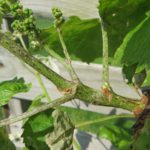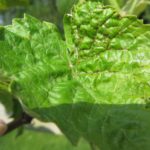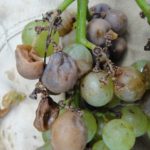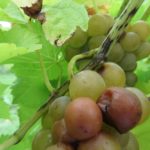The weather this spring has been ideal for development of Phomopsis cane and leaf spot. The past few weeks have been cool with frequent showers, and shoot growth has been slow. These conditions favor sporulation and infection by Phomopsis. This pathogen is one of the major causes of fruit rot in the Midwest. Early season infections of shoots, cluster rachises and berry stems remain latent until veraison. Then as the fruit begins to ripen, the fungus resumes development and infects berries and girdles cluster stems. Damage can be severe and fruit quality greatly diminished. If a few sprays were missed and infections have occurred, infected shoots should be removed during shoot thinning to minimize problems later. Now that the weather is warmer, new infections are less likely. But, any infected shoot can result in fruit rots later. Remove those during shoot thinning if possible.
- Phomopsis shoot and rachis infection
- Phomopsis leaf spot
- Phomopsis shoot infection
- Phomopsis rachis infection
- Phomopsis rachis infection and berry rot




